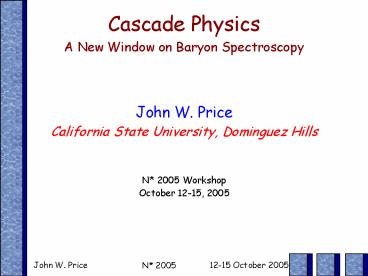Cascade Physics A New Window on Baryon Spectroscopy - PowerPoint PPT Presentation
Title:
Cascade Physics A New Window on Baryon Spectroscopy
Description:
John W. Price. California State University, Dominguez Hills. N ... Price et al., PRC 71, 058201 (2005) Careful analysis yields very clean signal. John W. Price ... – PowerPoint PPT presentation
Number of Views:21
Avg rating:3.0/5.0
Title: Cascade Physics A New Window on Baryon Spectroscopy
1
Cascade PhysicsA New Window on Baryon
Spectroscopy
- John W. Price
- California State University, Dominguez Hills
- N 2005 Workshop
- October 12-15, 2005
2
Outline
- Motivation for ? studies
- Description of ? program
- Summary and call for help
3
Why Cascades?
- N physics getting hard to do
- Need lots of data
- Need complicated computer analysis
- Interpretation difficult
- States broad, overlapping
- We need another type of particle that...
- ...is narrow easy to isolate
- ...is otherwise similar to N
4
Why Cascades?
- Cascade widths are 9 times narrower than N
widths
- related to ( of light quarks)2 in baryon
(941 ratio) Riska, Eur. Phys. J. 17, 297
(2003)
- Identifiable in a missing mass plot
5
SU(3)F symmetry
- LQCDL0Lm
- L0 same for all quarks
- L0 sets the mass scale for a given multiplet
- Lm sets the mass splitting within a multiplet
6
SU(3)F Multiplets
With only qqq states, SU(3)F gives four multiplets
7
Producing Cascades
- K-p?K?-
- Get Cascade with missing mass or reconstruction
- No suitable kaon beams available
- ?p?KK?-
- Detect KK, infer cascade in missing mass plot
- Small physics background none below 1.6 GeV
- Same technique used for all excited states
- Hall B, CLAS suitable
8
Quality of Cascade Data
- Recent publication indicates st(?p?KK?-)3.50.5
1.5 nb
- Careful analysis yields very clean signal
Price et al., PRC 71, 058201 (2005)
9
Cascades with higher statistics
- 70 pb-1 ?p data
- 1.6 lt E? lt 3.8 GeV
- Large ? production rate
- Sufficient for a ? program
- Talk by Lei Guo
- Session P2-C
10
Areas of study
- (Study of known/Search for missing) ?'s
- Study of the ?0 excited states
- ? production mechanism
- ? decay modes
- JP determination of the ?'s
- s-d quark mass difference
- ?p scattering
11
Known/Missing ? study
- Recall from SU(3)F symmetry
- Octets each N has a corresponding ?
- Decuplets each ? has a corresponding ?
- We're missing 14-33 ?'s
- Those we know aren't known well
- Only have JP for three states
- Much to learn from a survey of the ? spectrum
12
The ?(1950)
- 3-star state
- JP unknown
- something seen by several groups
- Large disagreement about mass
- The accumulated evidence for a ? near 1950 MeV
seems strong enough to include a ?(1950) in the
main Baryon Table, but not much can be said about
its properties. In fact, there may be more than
one ? near this mass.
13
Looking for new ? states
- Look for new ? states based on existing baryons
- Consider
- N(1535)½-?N(940)?
- ?(1670)½-??(1115)?
- S(1750)½-?S(1190)?
- Is there a ?(1870)½- that decays to ?(1321)??
14
?0 Properties
- ?0 detected by requiring an additional p-
- Mass must be near ?- mass
- ?m?(1321) 6.480.24 MeV
- ?m?(1530) 3.20.6 MeV
- Only other measurements N(940), ?(1232)
- Related to medium modification
15
The ? Production Mechanism
- ?'s must be produced via an intermediate state
- ? structure related to relative contributions of
these and other mechanisms - Different energy, angular dependence expected
- Much data, theoretical input needed to resolve
16
Decays of the ?'s
- ?-(1321) and ?0(1321) decays well-known ?p
- All ?'s decay strongly
- ?(1530)??p BR?(1530)???lt4
- ?pp channel opens up at 1585 MeV ?K at 1608 MeV,
SK at 1682 MeV - Can use BR's to distinguish nearby states
17
JP measurements of the ?'s
- 8 of 11 ?'s lack JP determination
- PWA technique not applicable
- Use ? decay to determine JP
- Method of Byers Fenster (PRL 11, 52)
- ???p, ???p used to find JP for ?(1530)
- Method of J. Button-Shafer (PR 139, B607)
- ???(1530)p
- Generalized by Minnaert (PL B66, 157)
- ???p and ???K
18
ms-md
- For octets 2(mNm?) 3m?mS
- For decuplets m?-mS mS-m? m?-mO
- Can only test with one decuplet and two octets
- Once JP is measured, place ?'s into multiplets
and compare with the above - Issue is ms-md the same for excited baryons as
it is for ground-state baryons?
19
?p scattering
- Very little work done on ?p scattering
- Useful for hypernuclear studies
- CERN data on st at 101.5 GeV/c and 133.8 GeV/c
- new KEK preprint upper limit of 24 mb for
elastic 4.3(6.3,-2.7) mb for ?-p???
Ahn et al., nucl-ex/0502010
20
Summary and Prognosis
- Cascade photoproduction has opened up a wide
range of research areas - Many things to keep experimentalists occupied
- We have a new window on baryon spectroscopy
- Lots of theoretical support needed
- Production models
- Lattice calculations (easier for cascades...)
- JLab ? workshop 1-3 December 2005
21
? Workshop
- December 1-3, 2005 _at_JLab
- Confirmed speakers
- A. Thomas
- G. Miller
- S. Capstick
- F. Iachello
- Look forward to seeing you there!































